GASTRONOMY OF HIDALGO
Typical Food of HIDALGO
The gastronomy of Hidalgo is made up of ancestral ingredients: corn, insects, meat, chili and spices, in combination with ancestral traditions and secrets that have resulted in a gastronomic fusion of very peculiar characteristics in this part of the country.
If something characterizes Mexican cuisine, it is the wealth of flavors and traditions that come together in its dishes. Not for nothing has it been recognized by UNESCO as Intangible Heritage and the gastronomy of Hidalgo is no exception.
If you want to pamper your palate with exotic and traditional food, be sure to try the barbecue, the pastes, the mixiotes and the great variety of dishes that are in Hidalgo, accompanied by a good pulque.
Typical Dishes of HIDALGO
Pastes
Let’s start our list with a dish from England: pastes. If a dish is famous in Hidalgo, it is the pastes of Pachuca and Real del Monte, whose origin dates back to colonial times as the English miners took them as an aperitif to their working days.
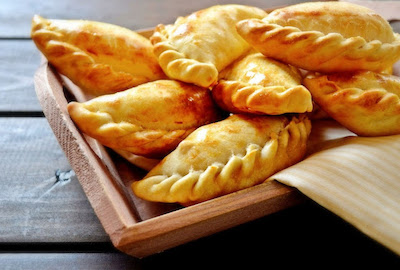
The “Pastes” are a kind of empanada made with wheat flour filled with ground meat, potatoes, salt, pepper and parsley. Its origin dates back to the time of colonial Mexico when mining activity was at its peak and the English workers from Pachuca and Real del Monte took them as an aperitif to the pits and holes where they extracted the silver.
They are made with puff pastry filled with a stew of potatoes, ground meat and parsley, this being the original recipe. Now they include sweet or savory fillings such as mole, tuna with potatoes, pineapple, blackberries, rajas, among others.
Tlacoyos
I can still hear the noise and smell the aroma that comes out of the frying pan with oil or butter where these snacks are fried, to later be prepared, served warm and lick your fingers after tasting them.
Tlacoyos are elongated corn tortillas stuffed with lima beans, peas, or dried beans, topped with red or green sauce, onion, fresh cheese, and cilantro to taste. Order these succulent snacks at local markets and inns.
Mixiotes
If there is something that characterizes the Hidalgo plains, it is its landscapes populated with maguey pulquero crops, from whose stalks a film called “mixiote” is extracted, which gives the name to this delicious dish.
The mixiotes are filled with a stew that can be marinated beef, chicken or rabbit, wrapped in this film that gives it a touch of maguey flavor. They are steamed in a water bath and can be served with red rice. All a delight.
Barbacoa (Mexican Barbecue)
The barbecue is perhaps one of the most typical dishes of Hidalgo whose preparation is pre-Hispanic heritage. The oven where this succulent dish made with lamb, beef, venison or rabbit will be cooked must be earth.
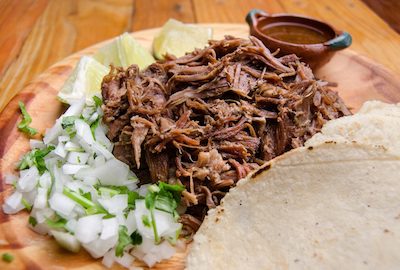
The meat in pieces is wrapped in the leaves of the maguey plant that gives it a very peculiar flavor, and is then placed in a hole in the ground one meter deep and half a meter in diameter.
It is accompanied with freshly made blue corn tortillas, the consommé with all the juices that the meat releases in its cooking and ingredients such as chickpeas, rice and spices.
A good pulque or a cured from the region make the perfect pairing to taste this dish.
Xoconostle
Fruits of the nopal plant, a kind of prickly pear, pink inside and thick, bittersweet rind and a little strong. Its most common use is as a condiment in the delicious mole de olla.
It is also used to prepare sauces or as a drink in smoothies, as its properties include the decrease in blood sugar.
Zacahuil
This typical dish from the Huasteca of Hidalgo is a huge tamale one or two meters long, made with corn dough stirred with lard, salt, spices and ground chili peppers, stuffed with stewed beef, pork, chicken or turkey.
Once the tamale is made, it is wrapped in banana leaves and cooked in wood ovens. When cooked, its edges are more golden than the center, which is known as glued. Its crunchy flavor is delicious.
Tecotitos
They are made with nixtamal, lard, salt and ingredients such as potato, mint, chicken, pipián and Mexican sauce are added; they are wrapped in corn husks and cooked on a comal.
Moles de Jacala
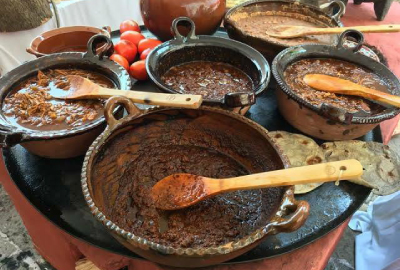
The most famous in this region is the rabbit mole with pine nuts and walnuts, also known as pascal.
Like all moles, its preparation is based on chili peppers, sesame and spices; the filling can be with chicken or turkey meat, served with black beans and freshly made corn tortillas.
Gualumbos
When the pulquero maguey reaches maturity, flowers sprout on the stalks known as hen’s feet. They are edible flowers that are used as an ingredient in broths, stews, fillings for snacks and tamales. They are also used in the preparation of atole or as an accompaniment in the delicious chicken barbecue and other typical dishes of Hidalgo.
“Guajolotes”
A telera with refried beans spread and filled with a red or green enchilada, are the ingredients that make up these typical snacks from the town of Tulancingo. The enchiladas can be boiled egg, chicken or fried in lard, which gives these delicious turkeys a very particular flavor.
Chinicuiles
These small, red worms known as chinicuiles sprout at the bottom of the plant, after the autumn rains that bathe the magueys. Its name comes from the Nahuatl language “chilocuilin”, which means “chile worm”.
These insects are a delicacy in the gastronomy of Hidalgo. They can be prepared fried, toasted and enjoyed in tacos accompanied by a green or red molcajete sauce.
Escamoles
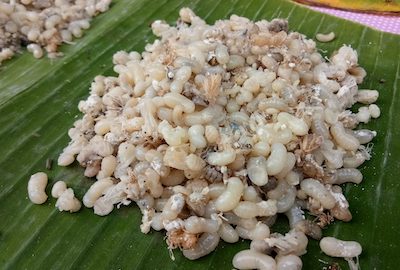
Its preparation has pre-Hispanic origin. They are eggs or larvae of a güijera ant whose nests are formed under the nopaleras. It is an expensive dish due to its laborious production.
Escamoles are high in protein and taste great. You can taste them in soups, tamales, stewed with nopales, eggs or chili, although the ideal is to eat them with few ingredients to enjoy their characteristic flavor.
Ximbó
Its preparation is very similar to barbecue, as it is a stew wrapped in maguey leaves that is cooked in an earth oven. Although it is a typical dish throughout the state of Hidalgo, it is known that it had its origin in Actopan and San Salvador, belonging to the “Valle del Mezquital”.
The variant of the barbecue is that the Ximbó is made with pieces of chicken meat, pork skin, chamorro or rib, which result in an exquisite flavor.
Maguey worms
Insects are a staple of the gastronomy of Hidalgo and the Maguey Worms, a very famous dish. They are raised on the maguey stalks and the ideal time to extract them is in the rainy season, a process that makes them a rare and precious dish.
The process of making the dish is not very complex. They are served browned with tortillas and a good sauce, which gives them a somewhat strong and crunchy flavor when biting into them.
Typical Drinks of HIDALGO
Pulque
The maguey is the main ingredient of pulque, a traditional drink of pre-Hispanic origin. During the colony its consumption grew and became popular, and by the time of the Porfiriato it became one of the most important industries in the country that even demanded extensive stretches of railway lines for its transport to the country’s capital.
Fermented drink that is extracted from the mead of the magueys, the plains of Apan and the Valle del Mezquital. There are also “curados” which are fruit or seed juices that are added to pulque, resulting in a touch of sweet and fresh flavor. Currently the traditional flavors of pulque are: celery, guava, pine nut, tomato, among many others).
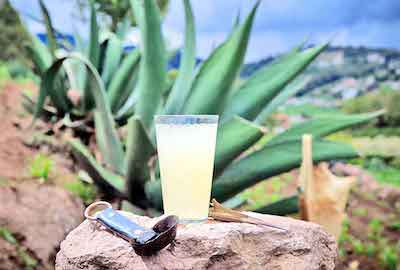
Although its production and consumption have decreased significantly, it is possible to find very good pulque in some farms in the municipalities of Zempoala and Singuilucan, as well as in some regional food restaurants.
Pulque is the quintessential liquor in Hidalgo, but there are other drinks made with corn, brown sugar, seeds, fruits and plants, such as Tachuela, Requintada, Acachul, Achocote, Rompopes de Huasca de Ocampo and Licores de Tlahuelompa, also very tasty.
“Tachuela” (Tack)
This drink originates from the magical town of Mineral del Chico, it is typical of the region and very rich. Its preparation is a secret, it is known that it is made from wild herbs and fruits; It has the peculiarity of removing the hangover and not leaving an alcoholic breath. And there are several establishments that serve it in a tequila shot glass accompanied by a Maria cookie. The origin of its name is curious since it is due to the fact that its shape resembles the nails that the miners put in their soles to avoid slipping in the mines.
“Requintada”
A delicious typical product from the Atotonilco region is the requintada, which is a green drink made with wormwood, anise, mint and brandy. According to the locals it is used to cure stomach ailments, so a drink is good after a meal. This drink dates back to the 19th century.
Acachul
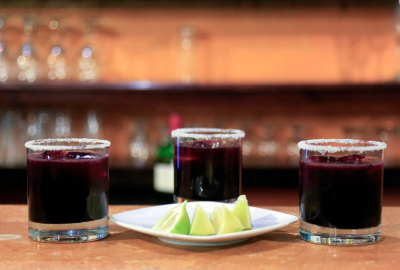
This delicious drink, also known as Sherry Type Table Wine, is made with a base of 70% apple juice for all flavors until it is fermented, then the flavors of natural fruits and sugar are added. The best known is the acachul, a fruit native to Acaxochitlán, it is a small fruit similar to the capulín that occurs in the wooded and cold area of the municipality. Apple, quince, capulin, blackberry, perón table wine is also made.
Achocote
Achocote is a popular drink from Hidalgo that is made from corn and piloncillo. An atole is made with 3/4 cup of corn, 1 liter of water and piloncillo to taste. Then you have to empty a glass container or clay jug, cover and leave it at a warm temperature for about 4 days. It is served cold and is a totally refreshing drink.
Liquors from TLAHUELOMPA
Liqueurs made from delicious fruits from the Sierra Hidalguense region, are made by Huasteco producers from the community of Tlahuelompa, in the municipality of Zacualtipan. Made with cane brandy and fruit wine with blackberry, lemon, orange, guava, apple, etc. A recommendation, it is common for them to give you a little taste, and as rich as they are, one can get well served, the road is 10 km. From curves to reach Zacualtipan, an accident will not occur.
Eggnogs from HUASCA DE OCAMPO
Although it is not originally from Hidalgo, Huasca’s handmade eggnogs have become a must stop on any tourist tour in the region, with recipes that were learned in the convents, Juana Lugo, Director of the Artisan Company, learned the secrets of the nuns , only when he was 13 years old, with all the experience of 4 decades in the manufacture and with talent for the kitchen, San Juan Artisan products have embodied a characteristic stamp of good taste in their traditional eggnogs, we particularly recommend the one of almond.
Aguamiel (Mead)
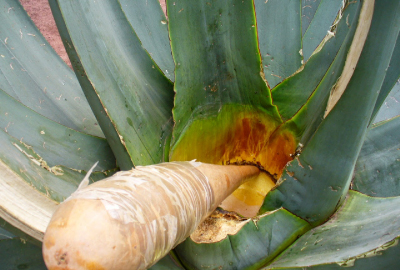
This typical drink from the State of Hidalgo is made with natural mead to which other ingredients are added, such as ground chili or regional fruits such as tunas, pitayas or garambullos, it is also known as syrup, tlachique, syrup or agave honey, it is the sap that contains the heart of the plants known as magueyes; belonging to the agave family, especially the maguey pulqueros.
Mead is the basic material with which pulque is made, an alcoholic beverage of pre-Hispanic origin that is still consumed in the central states of Mexico, mainly in Hidalgo. To extract the mead it is necessary to wait for the maguey to mature for approximately eight years. The heart of the succulent is pierced with a knife, and the tlachiquero (person dedicated to the extraction of mead) introduces his elongated acocote into the hole, from which the mead flows.
In some regions of Mexico, mead is a drink of daily consumption, especially in the Hidalguense and Potosino semi-desert regions. It contains a large amount of sugars and proteins. It is also used in the preparation of breads and other culinary creations of the inhabitants of the Mexican Plateau.
Pozol
Pozol is the drink that we find with the greatest presence in the Sierra Alta de Hidalgo and we know that it is another of the drinks that represent Mexico, since it is made mainly of corn.
Typical Sweets and Desserts of HIDALGO
Hidalgo has a very rich gastronomy and it is something that cannot be denied, best of all is that within its culinary art it has delicious sweets and desserts that will leave you wanting more.
“Palanquetas” (Walnut bars)
It is one of the richest sweets that we can find in the entire Mexican Republic, both in artisan markets, as well as in street vendors on the busiest avenues in each region.
Pulque bread
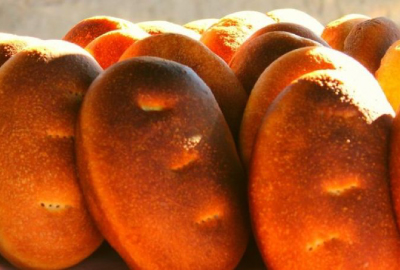
Pulque bread is part of the sweets of San Luis Potosí and Hidalgo. But this is not due to the closeness of these two states. This is because pulque bread is part of the gastronomy of Tlaxcala that was very successful and that several “pulquero” states of Mexico adopted into their culture.
Tamarindo candy
Tamarind sweets can be found in various presentations, either from pulp or from crystallized sweets, but they are undoubtedly one of the best that we can find when visiting Mexico.
Fruit “ate”
Fruit ates cannot be missing from Hidalgo’s list of artisan sweets, but they are really prepared in almost all of Mexico and it is a healthy option due to its ingredients.
Pinole “gorditas”
Pinole is considered a pre-Hispanic food from Mexico that is made with toasted cornmeal, sweetened with piloncillo and cinnamon. Well, the gorditas de pinole refer to some delicious thick circular cookies that are prepared with pinole flour.
“Pastel de Nopal” (Cactus cake)
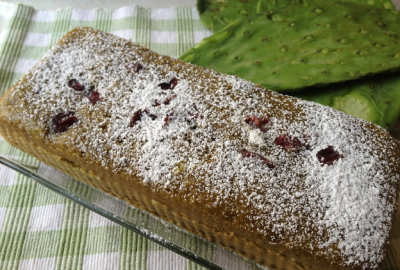
Pastel de nopal is a traditional Hidalgo dessert. It is prepared with nopal and was also brought from other Mexican latitudes and as a complement it can be eaten with an atole, such as masa to make it a true traditional snack.
Pepitorias
If there is something that hidalgo gives us and that is very unlikely to be found in other states, it is the Pepitorias and if you do not know what they are, we will now define it for you: They are handmade sweets that are made with different seeds or nuts.
Xoconostle ice cream
Although there are lemon, strawberry, and coconut ice creams, the one that is truly traditional from Hidalgo is Xoconostle ice cream.
Cocadas (Coconut Sweet)
Coconut sweets, also known as coconut cocadas, are of Spanish origin and remained within Mexico after the conquest. These sweets can be found in almost any artisan market in Hidalgo and are prepared with grated ripe coconut, milk, cinnamon, and sugar.
More Tourist Attractions in HIDALGO
Guided Tours in HIDALGO
Flights & Hotels in HIDALGO
More Tourist Attractions in MEXICO

Archaeological Sites
The Archaeological Zones are the cultural past of every Mexican. You will be amazed at the ambient, nature and the environment that surrounds them. Climbing to the top or being around it will take us back in time to admire every detail. México is a country of culture and traditions, many of which we have inherited from the pre-Hispanic inhabitants of this vast territory, although it is true that there were more settlements in the central and southern part of the country, it is also possible to find some archaeological remains in the north.
… Read More

Traditions in Mexico
It is practically impossible to make a meticulous, and above all, accurate selection of the places to visit in Mexico. Each place that our country houses is unique and beautiful in its own way. Mexico, with its nearly 2 million km², has a large number of scenarios to offer, as well as endless activities to do. Do not lose your way and enter the places to visit in Mexico. In Mexico, apart from the beaches and its famous archaeological sites, there are many other really interesting sites and activities that you should know. In the surroundings of the main cities you will find places full of culture and tradition, where you can spend relaxing, interesting and fun vacations. On your trip through Mexico you cannot stop obtaining souvenirs, the crafts that are made here are of the highest quality and recognized worldwide. A shopping tour cannot be missed.… Read More

Capital Cities
Folklore, gastronomy, literary culture, art and exhibitions, is what you will find in the capitals of the states of Mexico. To the north, colonial Mexico, Puebla, Guadalajara, Guanajuato, the Sonoran desert and the California peninsula. To the east Veracruz and the gulf. To the west Acapulco, Oaxaca and Tuxtla Gutiérrez. And to the south the Riviera Maya and the pyramids of Chichén-Itzá, Tulúm and Cobá in Yucatán, Palenque in Chiapas, the cenotes, and the Central American jungles.… Read More

Beaches
On the Beaches of Mexico you can immerse yourself in the intense blue ocean of the Pacific bays, sunbathe on the shore of the warm and transparent waves of the Caribbean Sea in Quintana Roo or even rest on the beautiful coasts of the Gulf of Mexico. Mexican beaches hide wonderful secrets for the traveler. By visiting them, in addition to enjoying the excellent climate and water activities, you can discover splendid archaeological sites and interesting colonial cities without traveling long distances.… Read More

Gastronomy
The Gastronomy of Mexico has a great diversity of typical dishes, which is why it was recognized by UNESCO as Intangible Heritage of Humanity. The basic and representative ingredients of Mexican dishes are: corn, coriander, chili, beans, piloncillo, nopal and tomato. Mexican cuisine is also characterized by its sauces, which serve as an accompaniment to traditional dishes, prepared based on spices.… Read More

States Of Mexico
Mexico has an incredible diversity of landscapes, where the beauty of its beaches, internationally recognized, stands out. In its vast territory of coasts, there are beaches of unparalleled beauty, and colorful landscapes. A large network of first-class hotels and tourist services is available to visitors to these beaches. Mexico is also mystical places, dotted with archaeological testimonies inherited from its original inhabitants. Monuments made by the Mayas, Aztecs and Toltecs are located in magical landscapes, like lighthouses in an ocean of natural beauty. They offer visitors buildings that tell their history, and museums that collect their cultural heritage. And that keep alive ancestral traditions, in ceremonies and festivals, where you can enjoy cultural activities and entertainment.… Read More

Ecotourism and Adventure
Mexico is one of the best countries for Ecotourism as it has a great variety of flora and fauna, as well as a large number of refuges for extraordinary species. You can enjoy recreational activities of appreciation and knowledge of nature through contact with it, such as: stargazing, observation of natural attractions, wildlife and bird watching. Throughout México there are more than 176 protected natural areas, 5 of them considered by UNESCO as Natural Heritage of Humanity. Just for this and much more, we believe that Mexico is a Paradise for Ecotourism.… Read More

Magical Towns
A Magical Town is a place with symbols and legends, towns with history that in many cases have been the scene of transcendent events for our country, they are places that show the national identity in each of its corners, with a magic that emanates from its attractions ; visiting them is an opportunity to discover the charm of Mexico. The Magical Towns Program contributes to revalue a set of populations in the country that have always been in the collective imagination of the nation and that represent fresh and varied alternatives for national and foreign visitors. A town that through time and in the face of modernity, has conserved, valued and defended its historical, cultural and natural heritage; and manifests it in various expressions through its tangible and intangible heritage. A Magical Town is a town that has unique, symbolic attributes, authentic stories, transcendent events, everyday life, which means a great opportunity for tourist use, taking into account the motivations and needs of travelers.… Read More

